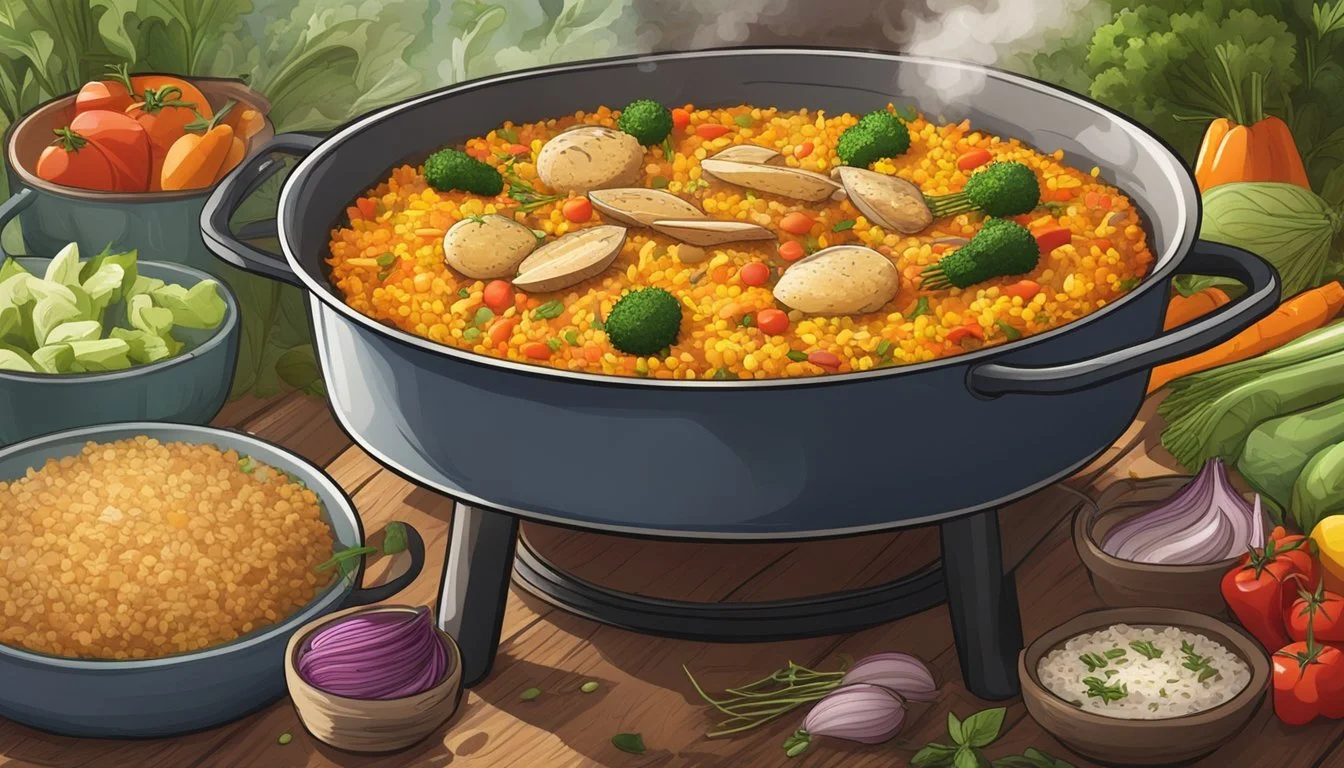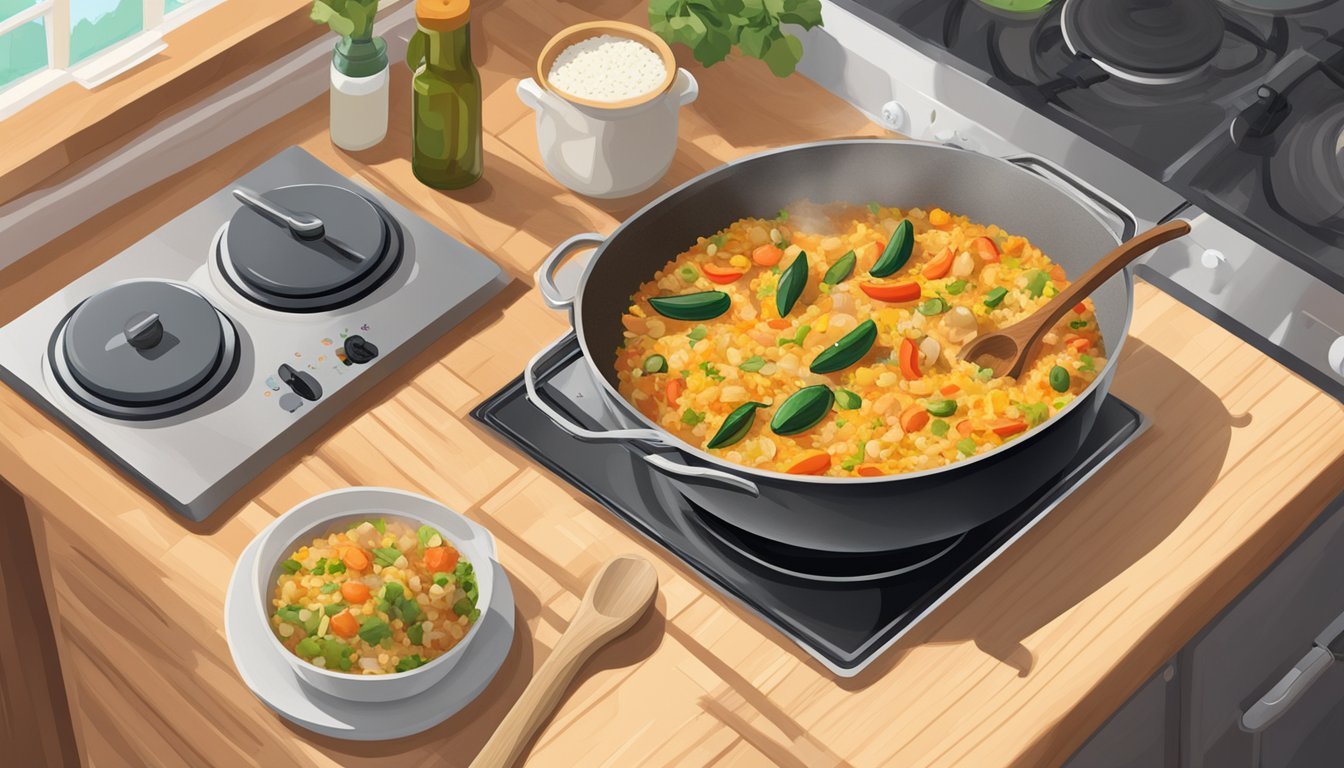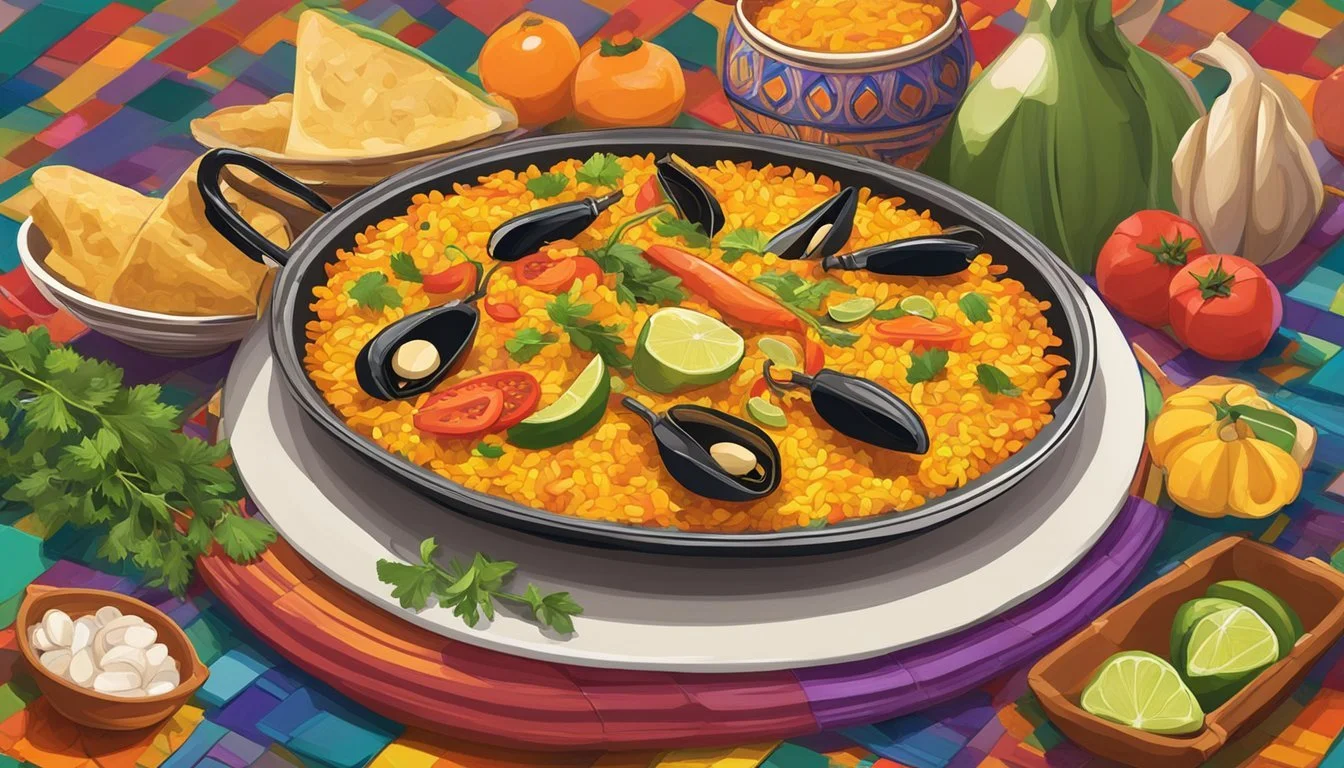How Long Does Gluten-Free Paella Last?
Shelf Life and Storage Tips
Gluten-free paella is a delicious and hearty dish that is perfect for anyone looking to avoid gluten while still enjoying Spanish cuisine. When stored properly in an airtight container and refrigerated, gluten-free paella can last up to 3-4 days. This makes it a convenient option for meal prepping or simply extending the enjoyment of your culinary efforts over multiple days.
The blend of fresh seafood, vegetables, and spices ensures that the dish remains flavorful even after a few days. Keeping the dish at a consistent cold temperature is crucial to maintain its taste and safety. If you want to extend the shelf life further, consider freezing it. Frozen gluten-free paella can be stored for up to 2 months, making it available for a quick and easy meal whenever needed.
Gluten-free paella also benefits from proper reheating methods. Using a stove or oven to reheat the paella can help preserve its texture and flavor, rather than using a microwave, which might result in sogginess. By understanding the best practices for storage and reheating, you can enjoy your gluten-free paella at its best for days to come.
Understanding Gluten-Free Paella
Gluten-free paella is a versatile Spanish dish made using specific grains and ingredients that ensure it remains safe for those avoiding gluten. Below, we'll explore what differentiates gluten-free paella and highlight the key ingredients involved.
What Makes Paella Gluten-Free?
Gluten-free paella avoids any ingredients containing gluten. This primarily involves using specific types of rice such as bomba rice, arborio rice, or valencia rice.
These rices are naturally gluten-free and absorb flavors well. Cross-contamination is a critical concern, so all utensils, cookware, and surfaces must be gluten-free. Additionally, gluten-free chicken broth or vegetable stock should be used instead of regular stock.
Finally, all spices and seasonings like saffron, paprika, and turmeric must be checked to ensure they are free from gluten-based fillers.
Key Ingredients of Gluten-Free Paella
The primary ingredient in gluten-free paella is the rice. Varieties such as bomba, arborio, and valencia are ideal due to their ability to absorb liquid while staying firm. Seafood like shrimp, mussels, and squid often feature in the dish, accentuating its Mediterranean flair.
Chicken is another common addition, providing a hearty protein source. The dish is flavored with saffron, a spice that gives paella its distinctive color and depth.
Other essential ingredients include onions, garlic, bell peppers, and canned diced tomatoes. Frozen peas are often added, and fresh parsley and lemon juice are typical garnishes to enhance the flavor profile. Ensuring all these components are gluten-free is vital for the safety of those with gluten intolerance.
Proper Storage of Gluten-Free Paella
Properly storing gluten-free paella ensures that it retains its taste and safety for later consumption. Follow these guidelines closely to make sure the dish stays fresh whether you refrigerate or freeze it.
Refrigeration Guidelines
To store gluten-free paella in the refrigerator, first allow the dish to cool to room temperature. Transfer the paella into an airtight container to prevent moisture loss and contamination. Keep the container sealed tightly.
Refrigerate the paella at a consistent temperature of 40°F (4°C) or below. Under these conditions, the paella can safely stay in the refrigerator for up to 3-4 days. It's important to avoid leaving the paella at room temperature for longer than 2 hours as this can foster bacterial growth.
Reheat the paella thoroughly to at least 165°F (74°C) before consuming to ensure its safety. Use either a microwave or stovetop, stirring occasionally to evenly distribute the heat.
Freezing and Thawing Instructions
For longer storage, freezing gluten-free paella is a viable option. Ensure the paella is completely cooled before transferring it into freezer-safe airtight containers or heavy-duty freezer bags. Label each container with the date to keep track of its age.
Store the paella in the freezer at 0°F (-18°C) or lower. Gluten-free paella can last in the freezer for up to 2-3 months.
To thaw frozen paella, transfer it from the freezer to the refrigerator and let it thaw overnight. For a quicker method, use the defrost setting on your microwave. After thawing, reheat the dish to a minimum internal temperature of 165°F (74°C) to ensure food safety. Avoid refreezing thawed paella to maintain its quality and safety.
Shelf Life Determinants
The shelf life of gluten-free paella is influenced by multiple factors, including the ingredients used and the cooking method. It's crucial to consider these elements to ensure the dish remains safe and tasty for consumption.
Influence of Ingredients on Shelf Life
The ingredients in gluten-free paella significantly affect its shelf life. Seafood, for example, is highly perishable. Paella featuring shrimp, mussels, or other seafood should be consumed within 1-2 days if stored in the refrigerator.
On the other hand, chicken and vegetables tend to last a bit longer, typically 2-3 days when refrigerated. Olive oil used in the recipe helps to preserve certain elements by keeping them moist. Spices like smoked paprika and saffron threads add flavor but don’t impact longevity.
Proper use of stock is essential. A freshly prepared stock will enhance the paella’s taste and help determine its shelf life.
Impact of Paella Pan and Cooking Method
The type of paella pan and cooking method also play a role in how long the dish remains fresh. Cooking paella in a traditional paella pan allows for even heat distribution, which ensures that all ingredients are properly cooked.
If the paella is evenly cooked, there is a lower risk of uneven cooling, which can cause spoilage. The pan material should be conducive to maintaining the dish at safe temperatures.
Additionally, whether the paella is cooked on a stovetop or in the oven can influence its longevity. Ovens often provide a more consistent temperature, minimizing bacteria growth risks compared to stovetop methods. Ensuring the paella is stored in an airtight container after cooling will also extend its shelf life.
Health and Safety Considerations
When storing gluten-free paella, it's crucial to maintain safety and avoid cross-contamination. Recognizing signs of spoilage and understanding gluten cross-contamination risks are vital to ensure the dish remains safe to consume.
Identifying Spoilage Signs
Proper storage can help prolong the shelf life of gluten-free paella. Freshly prepared paella typically lasts 3-4 days in the refrigerator.
Signs of spoilage to watch out for include:
Off-putting odor: A sour or unpleasant smell indicates the paella is no longer safe to eat.
Discoloration: Any unusual changes in color, such as dull or greyish tones, suggest spoilage.
Texture changes: If the rice or other ingredients become slimy or overly soft, it's a sign of bacterial growth.
Always discard paella if there are signs of mold or if the storage time exceeds recommended limits to avoid foodborne illnesses.
Gluten Cross-Contamination Risks
For individuals with celiac disease or gluten sensitivities, cross-contamination is a serious concern. Use fresh, naturally gluten-free ingredients like seafood, vegetables, and spices.
Preventing cross-contamination involves:
Clean utensils and surfaces: Ensure all cooking tools, countertops, and cookware are free of gluten residues.
Separate preparation areas: If gluten-containing foods are also being prepared, use separate areas or times to avoid mix-ups.
Certified gluten-free products: Opt for ingredients labeled as gluten-free, especially for items like broth, spices, and sauces.
Careful attention to these practices helps ensure the paella remains gluten-free and safe for all to enjoy.
Serving and Reheating
Reheating gluten-free paella requires specific techniques to maintain its texture and flavor. The following methods ensure your leftovers stay delicious and enjoyable.
Best Practices for Reheating
Reheating paella can be done using various methods, each suited to different needs. Microwave: Transfer the paella to a microwave-safe container, cover it with a damp paper towel to retain moisture, and heat for 2-3 minutes, stirring every 30 seconds. Stove: Place the paella in a heavy-bottomed pan with 2-3 tablespoons of water or stock. Cover and heat over medium for about 4-5 minutes, stirring occasionally. Oven: Preheat to 350°F, add a bit of water to the paella, cover with foil, and bake for 20-25 minutes.
Optimizing Flavor and Texture in Leftovers
For the best texture, avoid microwaving unless necessary; the stove or oven methods are preferable. When using the stove, ensure to stir occasionally to distribute heat and moisture evenly. The addition of a small amount of stock or water can help maintain the socarrat, the crispy bottom layer, without turning the rice soggy. In the oven, ensure the paella is evenly spread out and hydrated with a bit of liquid to keep it moist. This method allows the flavors to meld and revive closely to their original state.
Recipe Variations and Enhancements
Paella is a versatile dish that can be customized with various ingredients to cater to different dietary preferences and tastes. This section provides some ideas for vegetarian and vegan options, as well as protein add-ins and substitutions.
Vegetarian and Vegan Options
For those following a vegetarian or vegan diet, there are several tasty variations available. Escalivada, a mix of smoky roasted vegetables like bell peppers, eggplant, and tomatoes, can add depth and flavor.
Replace traditional seafood or meat with vegetables such as artichokes, green beans, and zucchini. Chickpeas or tofu can be used as protein alternatives. Vegetable broth should be used instead of chicken or seafood stock to maintain the dish's flavor while keeping it plant-based.
Protein Add-Ins and Substitutions
To create a protein-rich paella, various meats and seafood can be incorporated. Popular choices include shrimp, mussels, and prawns.
For a twist, consider adding sausage or chorizo for a smoky flavor. Chicken sausage is a leaner option. For a touch of luxury, lobster can be an excellent addition. It's important to ensure seafood is thoroughly cooked and the right consistency of the rice is achieved for the perfect dish.
Selecting the Right Cookware
Choosing appropriate cookware can influence the final texture and flavor of your gluten-free paella. The type of cookware also affects how well the dish holds up during storage.
Paella Pans vs. Alternatives
Paella pans are traditionally used due to their wide, shallow design, which allows for even cooking and the development of a crispy crust known as "socarrat." These pans are usually made from materials such as carbon steel, which distribute heat evenly.
Alternatives include:
Cast iron skillets: They retain heat well and can create a similar texture to a traditional paella pan but are heavier and may require a longer heating time.
Frying pans: These are more common in household kitchens but may not provide the same heat distribution and crust development.
Using alternative cookware can still yield a delicious paella, but it may lack the characteristic bottom crust that many enthusiasts seek.
Impact on Cooking and Storage
The material and type of cookware impact both cooking and storage:
Heat distribution: Proper heat distribution helps achieve even cooking. Paella pans excel here, but cast iron can also perform well if preheated correctly.
Storage considerations: Cookware like cast iron and carbon steel needs careful handling to prevent rust. Storing paella in these pans isn't advisable.
Paella maintains its quality when stored in airtight containers. However, transferring the dish from a paella pan to a container immediately after cooking helps preserve its texture and flavor.
Choosing the right cookware ensures your gluten-free paella cooks evenly and stores well, maintaining its quality and taste over time.
Maximizing the Longevity of Ingredients
Ensuring the freshness of ingredients used in gluten-free paella is critical. Proper storage and handling can significantly extend the shelf life of key components like seafood, meats, vegetables, spices, and herbs.
Proper Handling of Seafood and Meats
Seafood and meats are highly perishable and must be handled with care. Shrimp, mussels, and similar seafood should always be kept refrigerated at temperatures below 40°F (4°C). For best results, store them on ice in a container that allows for drainage to avoid water accumulation.
For meats like chorizo or chicken, keep unopened packages in the coldest part of the fridge. Once opened, store meats in airtight containers or tightly wrapped in plastic wrap to prevent exposure to air. Consuming seafood and meats within 1-2 days of purchase ensures maximum freshness and safety.
Storage Tips for Vegetables and Spices
Vegetables such as bell peppers, onions, and garlic should be stored in a cool, dry place. Ideally, bell peppers and onions should be kept in the refrigerator, while garlic is best stored at room temperature. Properly stored vegetales can last for up to a week or more.
Spices like turmeric, paprika, and saffron should be kept in airtight containers away from direct sunlight. This prevents loss of flavor and potency. Ensure that salt is stored in a dry place to prevent clumping and contamination. Olive oil should be stored in a cool, dark place to maintain its quality and prevent rancidity.
By following these storage and handling tips, the ingredients in gluten-free paella can remain fresh and flavorful for an extended period.
Cultural Significance of Paella
Paella, an emblematic Spanish rice dish, has deep cultural roots, especially in Valencia, where it originated. Its historical and regional significance underscores its status as an integral part of Spain's culinary heritage.
The Origins and History
Paella originates from the Valencia region on Spain's eastern coast. The dish traces its roots back to the 15th century, when rice became a staple due to advanced irrigation systems first developed by the Romans and refined by the Moors.
"Canaillas" or "bombetas" rice, indigenous to Valencia, forms the authentic base of traditional paella. This dish was initially a peasant's meal, composed of locally sourced ingredients like rabbit, chicken, and vegetables seasoned with saffron. Over time, it evolved from humble origins to become a symbol of Spanish cuisine.
Saffron is critical in paella, offering a unique flavor and vivid yellow color that distinguishes the dish. The shallow, wide cooking pan, called "paella," also lends its name to this iconic meal, emphasizing the importance of both the method and the dish itself.
Regional Variations and Traditions
Different regions in Spain have their unique interpretations of paella. In Valencia, the traditional version, known as Valencian paella, typically includes ingredients like rabbit, snails, and green beans.
Coastal areas might favor Seafood Paella, rich with shrimp, mussels, and fish, celebrating the maritime bounty. Each region adds its twist, with variations incorporating ingredients like chorizo, artichokes, or even duck.
These regional differences highlight paella's versatility and the locals' creativity. Festivals and gatherings often feature paella cooking as a central activity, emphasizing its role as a communal dish that brings people together, reflecting its cultural importance across Spain.
While the traditional aspects remain cherished, regional adaptations ensure that paella continues to evolve, maintaining its relevance and cherished status within Spanish culinary traditions.
Conclusion
Gluten-free paella can be stored in the refrigerator for up to 3-4 days. It's critical to store the paella in an airtight container to maintain freshness and prevent contamination.
When reheating, it's recommended to use the stovetop over medium heat. Avoid microwaving, as it can cause the rice to become mushy. Adding a bit of water or broth when reheating can help restore moisture.
For optimal flavor and texture, many chefs suggest consuming the paella within the first two days. This ensures the dish remains as close to its original state as possible.
If you need to store it longer, freezing is an option. Place the paella in a freezer-safe container or heavy-duty freezer bag. Properly stored, it can last for up to 3 months.
Clearly label containers with the date of preparation to keep track. Thaw frozen paella in the refrigerator overnight before reheating on the stovetop.
In summary, following these storage and reheating guidelines will help maintain the quality of your gluten-free paella.












